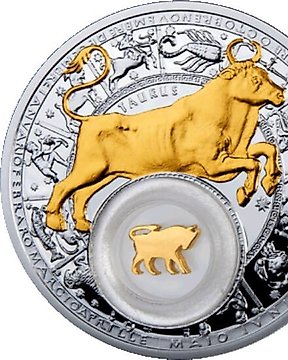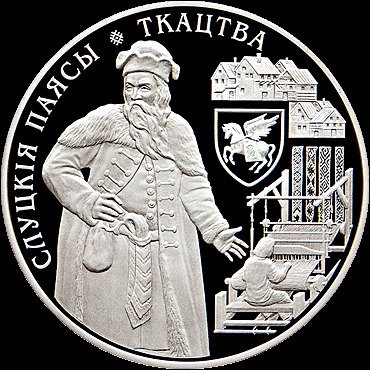
Hviderusland. 20 Roubles 2013 Taurus, Proof (Ingen mindstepris)
Nr. 82972257

Nr. 82972257

Name (ENG): The Belts of Slutsk. Weaving
Series: Coins of the Belts of Slutsk Series
Denomination (BYN): 20
Metal: Ag 925
Weight (gram): 33.62
Quality: PROOF
Diameter: 50.00
Issue Limit, pcs.: 7,000
Issue Date: 2013
Net pure one ounce (31.1 grams) silver coin. Includes original certificate of authenticity and information booklet.
The belts of Slutsk are the articles of silk handweaving which were produced by the manufactory of the Belarusian town of Slutsk during the period from the mid 18th to the mid 19th centuries.
In the second half of the 18th century the surge of fashion for the oriental colouring, including the luxury kuntush belts produced from silk threads, led to the organization of their manufacturing in different regions of the Polish-Lithuanian Commnwealth (Rzeczpospolita). At that time, dozens of persiarnyas – weaving manufactories producing the belts following the oriental patters – were established in the territory of Belarus, Ukraine, and Poland. Although weaving was one of the old crafts in Belarus and its masters were able to produce excellent inwrought fabrics from traditional materials (flax and wool) using hand looms, the production of goods from imported materials (silk and gold threads), unknown technique of weaving, technical calculations, and many other things necessitated the mastering of new methods of production.
The weavers of the manufactory of Slutsk met all the challenges successfully. In the beginning of its functioning the manufactory’s activities were rested on the qualified employees from Turkey and Persia, while in its golden age all technical operations were carried out by the locals. Luxurious grooves cost much cheaper than imported ones.
A new type of belt with a simple and expressive architectonics was designed in Slutsk. It consisted of a central area (the biggest and composition-monotonous part) and two belt-ends (composition-accented parts). The central area incorporated unornamented or ornamental vertical stripes; the belt-ends – two floral ornaments with full-blown flowers, the proportions of each ornament being equal to about 1/16 of the central area. The whole composition was edged (as if in a frame) by narrow bands – the galloons. The belt-ends were decorated by the sewn fringe. The majority of the belts of Slutsk were 2-4.5 meters long and 26-36 centimeters wide, that made them more compact compared with the oriental ones. The weavers of Slutsk became famous for the production of the so-called “molded” belts, which were mostly four-faced reversible belts woven by adding gold and silver threads. They were distinguished by the unusual gleam of metallic opalescence. Four different colour compositions made it possible to wear this belt in four different combinations.
Production of the belts of Slutsk, to be exact, the belts following their design, was organized in other weaving centres of Rzeszpospolita. A certain number of such belts was produced by the manufactury in Lyon, But, the original belts of Slutsk were and are valued higher than the belts of other producers.
The obverse had: the image of a fragment of the four-faced reversible belt produced by the manufactory of Slutsk (1760 (1762 – 1776). In both corners of the belt-end there is the marking “SLUCK”. Coloured silk, gold thread, weaving. The colours are: pale, black, crimson, dark blue, pink, white, and brown. The belt-end incorporates a double repeat of the floral motive of a decorative type – “flowering stubs”.
The belt is exhibited in the National Museum of History and Culture of Belarus.
The "Coins of the Belts of Slutsk" series contains 5 different coins:
- Nobleman's Dress
- Weaving
- The Radziwills
- Markings
- Collecting
This coin was personally purchased by the seller at the National Bank of the Republic of Belarus in Minsk, Belarus. To prevent environmental contamination, the coin has never been taken out of its capsule. Any scratches or irregularities are solely on the surface of the capsule.
Sådan køber du hos Catawiki
1. Opdag noget særligt
2. Afgiv det højeste bud
3. Foretag en sikker betaling